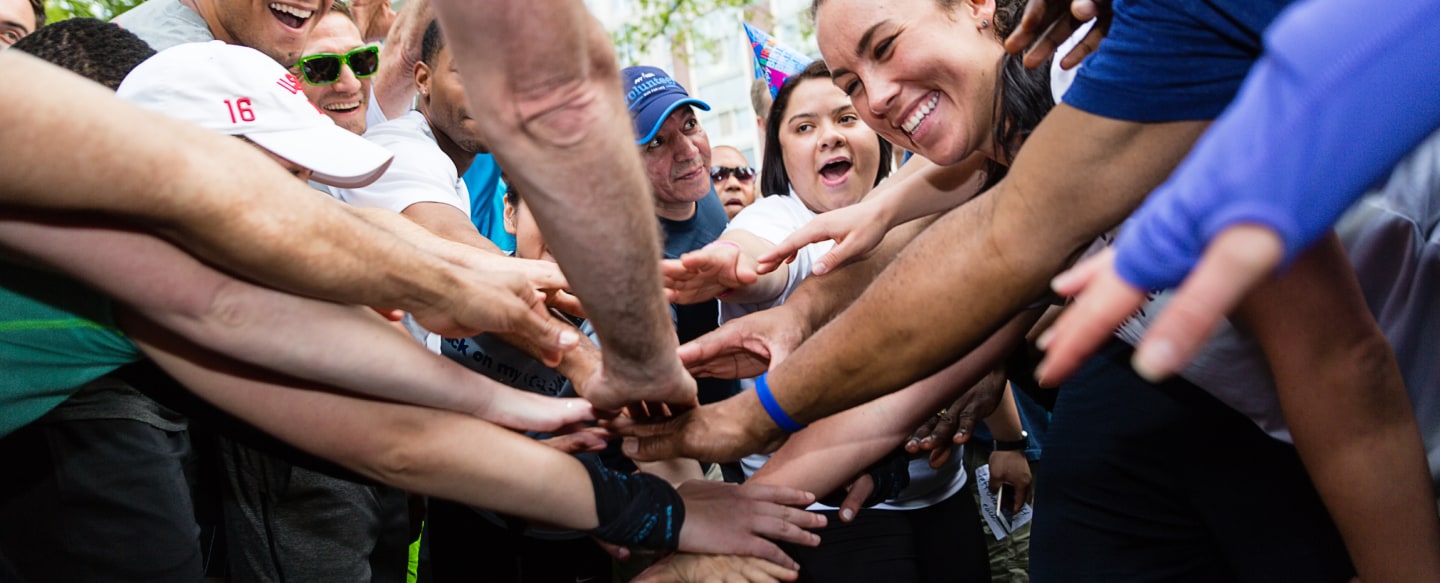Ask high school students what makes them feel the most vulnerable and speaking in front of the entire school usually tops the list. So imagine if you’re up on stage with another student who, after learning about your most personal memories, pretends to be you and reveals those stories to a packed assembly. A public speaking scenario that’s out of a teenager’s worst nightmare?
Not if the students are well versed in the Narrative 4 (N4) story exchange, a process that captures the power of storytelling in order to foster empathy, build trust, and create a feeling of belonging and connection. The results of N4’s unique process of getting to know a complete stranger by sharing intimate stories and then pretending to be that person by re-telling the stories back to them was on full display during the second half of a year-long exchange between the students of University Heights High School (UHHS) in the Bronx, New York and Floyd Central High School (FCHS) in Eastern, Kentucky.
Demonstrating the Power of Storytelling
Two students from the exchange sat on stage in the Bronx high school’s auditorium and spoke to hundreds of their peers by pretending to be the other person. Fatou, a senior from UHHS, choked up at certain points when she described in amazing detail what it’s like to come from a broken home in Kentucky while her counterpart, FCHS senior Lauren, looked on, also becoming emotional as she heard the stories of her own life acted out by someone else.
Afterwards, Fatou, a devout Muslim who wears a hijab, said she learned that she has a lot more in common with the students from the small Kentucky town (Muslim population: 0) than differences. “You need to go out there and learn for yourself,” said Fatou after the story exchange demonstration. “We’re all human and we all go through similar experiences.”
What began as an idea when a group of authors, poets, and other literary figures – led by the award-winning Irish writer Colum McCann, who co-founded the organization with CEO, Lisa Consiglio – met in 2012 to discuss the potential impact of storytelling became an independent, non-profit arts and education organization in 2013. Narrative 4 members began facilitating student exchange programs shortly thereafter, and the completion in March of the Floyd Central/University Heights exchange is one of its longest running to date.
High schools around the world are now jockeying to learn how to harness the power of N4’s special story exchanges. Social media tools and futuristic-looking “Shared Studio” pods, in which students from other countries can chat with each other in real time, have helped Narrative 4’s popularity. However, it’s the face-to-face story exchange that made the Bronx-to-Kentucky-and-back exchange particularly powerful. According to Hazel Joseph-Roseboro, principal of UHHS, the exchange has given her students a new sense of meaning and self-worth. “They’re not afraid to take a risk; to venture outside of New York City,” she said.
Breaking Down Stereotypes
The exchange program began last fall, when a group of students and chaperones from the South Bronx high school traveled to the mountains of eastern Kentucky. On paper, the exchange seemed to fortify stereotypes: What would happen when high school students from one of New York City’s most ethnically diverse neighborhoods traveled to Appalachia to spend a week with students in a predominantly white town in the heart of the Bible Belt?
In fact, when UHHS senior Omar asked his fellow Bronx students what first came to mind when he said “Kentucky,” the overwhelming response was “Trump.” “We thought [the exchange] was going to be political. But with Narrative 4, I was able to empathize with why they believed in Trump. Imagine a coal miner making $100,000 a year and that job goes away. And the president promised to bring those jobs back,” he said. “It’s important to have perspective. Without it, you make quick judgments. You need to know why people say what they say and do what they do.”
Part One: Kentucky
During the first half of the exchange in Kentucky, students from the two high schools were paired up, but stayed in different cabins on a local campsite. By the end of the week, however, students from both high schools were rooming in the same cabin, often talking – and debating – late into the night about the many issues that both of their communities have in common. “Everyone knows that the Bronx is not portrayed well in the media. But it’s just another community of people who care about each other, enjoy friendships, and want their neighborhoods to prosper,” said Emily, a FCHS junior.
“When we first started meeting, we got into discussions about faith and race that highlighted our differences. Then we got into the similarities and discovered that we shared values even though we didn’t necessarily agree on everything,” said Preston, a FCHS sophomore who said he would like to study law or international studies and possibly run for political office someday. “I’m going to incorporate altruism into whatever I do, if not center my career around it,” he said.
The students involved in the exchange chose mental health as a central theme on which to focus their exploration of both Appalachia and the South Bronx. Shawna-Gay, a senior at UHHS, said that the mental health theme reflected the overall Narrative 4 dynamic: sharing experiences, approaching the stories of others with an open mind, and creating a bond. To be sure, there are more places and resources to deal with mental health issues in a large city than in a small town, she said. “But overall we want to make it known that it’s OK to talk about mental health. It’s OK to be different and it’s important to accept people for who they are,” she said.
Part Two: The Bronx
During the second half of the exchange in the Bronx, students from both high schools heard from a brother and sister who came to America from Mexico. The duo shared their stories about how mental health challenges are common among immigrants as they attempt to settle into new homes after surviving long, harrowing journeys. Mental health among immigrants from America’s southern border might be underreported in the national press, but it’s an issue that the students associated with Narrative 4 have investigated in-depth. “You can’t take what is given to you by the media. You need to go out there and learn for yourself. We’re all human and we all go through similar experiences,” said Fatou.
Lauren, a junior from FCHS, reflected on the entire exchange after her classmates had returned from the Bronx to Kentucky. “When people talk about a story exchange, there’s often an assumption that it’s a light and fun thing to do and won’t really work. But it takes a lot of strength. A lot of vulnerability. It’s about being able to see how experiences change people. It really does change the way you look at the world, but also how you look at yourself. You’re constantly empathetic.”
Catching the Attention of Academia
During the past few years, researchers from the University of Chicago’s Psychology and Comparative Human Development departments were allowed to watch various exchanges and interview students before and after the sessions at UHHS. Dr. Rebecca Frausel was on hand during the opening day of the Bronx half of exchange to present her team’s findings.
The researchers from the University of Chicago found that Narrative 4’s story exchange methodology uniquely draws on a combination of cognitive (awareness of another person’s internal emotions) and affective (appreciation of another person’s experiences) empathies. This combination is one of the many reasons the upperclassmen who have mastered the exchange tend to be approached by sophomores pining to learn it for themselves. Their study determined that students showed a significant increase in empathy – 36 percent of a standard deviation – immediately after an exchange, and many maintained heightened levels of empathy a full 10 days later. Additionally, Joseph-Roseboro, found that students at UHHS were more likely to have higher levels of attendance, lower amounts of conflicts at school, and improved grades. One of the most extraordinary findings? The more powerful and personal the story, the more likely the other participant will develop and maintain a higher level of empathy.
Mutual Respect Helps All of Us Succeed
At talent night during the Kentucky visit, Bronx senior Omar described Narrative 4 even better than its founders, according to participants. Asked by Joseph-Roseboro to put that description to paper, Omar collaborated with his fellow Narrative 4 ambassadors and came up with a fresh description that reflected all of their experiences. It’s proof that well after everyone was back in their respective schools and communities, the empathy and camaraderie the students developed and maintained was as strong as ever: “Narrative 4 brings people who would never have a chance to connect together and allows them to realize that they are all one. Human, capable, worthy, and powerful.”











